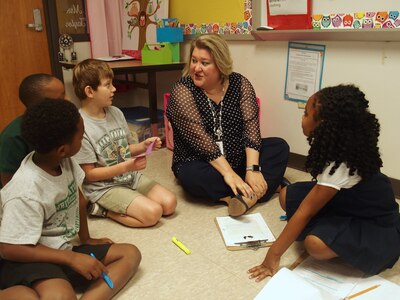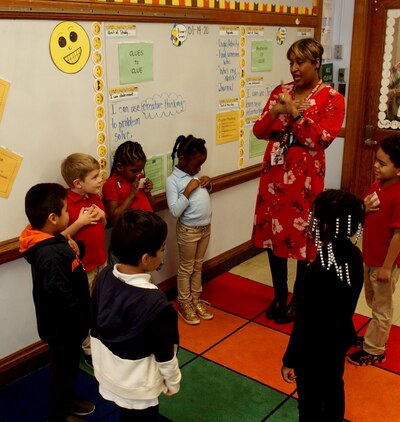Before this month, just one student between kindergarten and second grade, a white boy, was identified as gifted at Treadwell Elementary School in Memphis, where half of the students are black, more than a third are Hispanic, and just 4% are white.

Now, eight other students have joined him after Shelby County Schools switched to universal screening instead of relying on teacher recommendations to identify advanced students.
Across the district’s schools, 600 more Memphis students in kindergarten through second grade are starting this month in the district’s gifted education program, known as CLUE, which stands for Creative Learning in a Unique Environment. Another 600 older students are waiting for additional state testing to see if they qualify for the gifted program.
The additional K-2 students more than doubles the number last year identified as gifted in those grades, according to district data Chalkbeat requested. By expanding district testing to all elementary and middle school students, officials said this week that every district-run elementary school now has at least one student in CLUE.
As a result, more black students are represented in the program’s newest K-2 cohort. About 60% of newly identified elementary CLUE students are black, compared with last year’s 44%. Officials hope eventually the CLUE program can be more representative of the district’s racial makeup — nearly three-fourths of its students are black.
And in each ethnic group, more boys were identified than girls, which CLUE supervisor Jennifer Chandler said “almost never happens” in gifted education and called it a “huge win.”
“Parents no longer have to know the secret handshake to get in the door,” Chandler said of parents who have the resources to get their young children privately tested if a teacher does not recommend them for the gifted program. “We talk about how we want to serve all kids. Through this process, we now can say we can.”
The 600 additional students the district identified in grades 3 through 8 are waiting to take a state test for giftedness that is not required for younger students. Chandler said she hopes to finish that testing by spring break.
School board chairwoman Miska Clay Bibbs said Monday the data was welcome news, but also an indictment of the previous method of relying mostly on teacher recommendations.
“What this shows me is that we also need to do a culture shift around understanding how we treat our kids,” she told board members during a committee meeting. “I don’t care what building you’re in, there’s going to be some gifted kids in the building.”
Last year, one in five schools had no CLUE students, according to district data presented in August. More than 60% of schools had fewer than 10 students in CLUE.

At the beginning of the school year, Brownsville Road Elementary Principal Charles Newborn, said it’s not always as simple as a teacher misidentifying a student, though.
“You never know what you can find out about a student unless you have the data to show it,” he said.
The shift to universal screening increases access to more rigorous instruction for students who might have otherwise been overlooked in teacher recommendations. Other districts that have started universal screening have also seen increases in both the number and diversity of gifted education programs. Researchers say relying solely on teacher recommendations can be biased against black and poor students.
A recent study from Vanderbilt University and the University of Florida found that students from high-income families are seven times more likely to land in gifted programs than their other classmates with similar reading and math scores. Black students nationwide are far less likely to be placed in gifted programs, even if they have the same test scores as their white peers, and especially if their teacher is white, according to a 2016 Vanderbilt study.
Those students who are most often overlooked are also likely to gain the most from gifted programs, which are linked to greater student motivation and engagement in school.
Jonathan Plucker, an education professor at Johns Hopkins University, said universal screening expands access “for all the students we keep missing,” he told Chalkbeat.
“The odds that they’re being challenged appropriately probably aren’t great. And we know that challenge is so important to our kids… because when you’re challenged, that’s when learning takes place,” he said.
District leaders also hope the more challenging instruction will create a pipeline of students ready to take high school courses that award college credit, which would better prepare students for college-level work.
Though this year’s jump is significant, it will likely be a while before the effects are felt throughout the gifted program, now in its 50th year in Memphis. Even with the new additions, only 45% of the program’s students are black overall, up from 41% last year. The percentage of Hispanic students in the program overall remained steady at around 9%.
Last year, 15% of CLUE students were from low-income families, compared with more than three quarters of students in district-run schools. The district was unable to provide the new number of CLUE students from low-income families.

CLUE students in kindergarten through fifth grade are pulled out of class for two and a half hours, twice a week, to participate in more challenging coursework, usually with more projects and field trips. In sixth through ninth grades, CLUE is the student’s English class.
The district directly funds CLUE students in kindergarten through second grade. The state pays for third through ninth grade and is one of the few states nationwide that requires schools to work with parents to create a plan describing how to meet the gifted student’s academic needs. The requirement is more widely used for students with disabilities and ensures regular progress meetings and special instructions to teachers for the student.
The switch did not cost the district anything this year because officials used tests they already had access to, but the district plans to hire more CLUE teachers next year. The cost to screen that many students has been a deterrent to other districts, including in Nashville. That district piloted a universal screening for second graders in 2017, but dropped it because it was too expensive.

